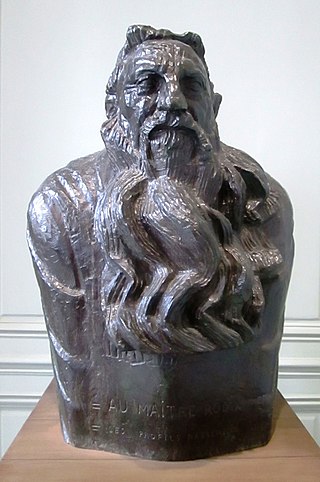
Antoine Bourdelle, born Émile Antoine Bordelles, was an influential and prolific French sculptor and teacher. He was a student of Auguste Rodin, a teacher of Giacometti and Henri Matisse, and an important figure in the Art Deco movement and the transition from the Beaux-Arts style to modern sculpture.

Jean-Baptiste Carpeaux was a French sculptor and painter during the Second Empire under Napoleon III.

Emmanuel Frémiet was a French sculptor. He is famous for his 1874 sculpture of Joan of Arc in Paris and the monument to Ferdinand de Lesseps in Suez. The noted sculptor Pierre-Nicolas Tourgueneff was one of many students who learned sculpture under the tutelage of Frémiet.

Marius Jean Antonin Mercié, was a French sculptor, medallist and painter.

The Farnese Hercules is an ancient statue of Hercules, probably an enlarged copy made in the early third century AD and signed by Glykon, who is otherwise unknown; he was an Athenian but he may have worked in Rome. Like many other Ancient Roman sculptures it is a copy or version of a much older Greek original that was well known, in this case a bronze by Lysippos that would have been made in the fourth century BC. This original survived for over 1500 years until it was melted down by Crusaders in 1205 during the Sack of Constantinople. The enlarged copy was made for the Baths of Caracalla in Rome, where the statue was recovered in 1546, and is now in the Museo Archeologico Nazionale in Naples. The heroically-scaled Hercules is one of the most famous sculptures of antiquity, and has fixed the image of the mythic hero in the European imagination.

Louis-Ernest Barrias was a French sculptor of the Beaux-Arts school. In 1865 Barrias won the Prix de Rome for study at the French Academy in Rome.

François Pompon was a French sculptor and animalier. Pompon made his Salon debut in 1879, exhibiting a statue of Victor Hugo's Cosette. He was a pioneer of modern stylized animalier sculpture. He was not fully recognized for his artistic accomplishments until the age of 67 at the Salon d'Automne of 1922 with the work Ours blanc. Pompon died in Paris, France, on 6 May 1933.

Antoine-Augustin Préault was a French sculptor of the "Romantic" movement. Born in the Marais district of Paris, he was better known during his lifetime as Auguste Préault.

The Musée Bourdelle is an art museum located at 18, rue Antoine Bourdelle, in the 15th arrondissement of Paris, France, located in the old studio of French sculptor Antoine Bourdelle (1861–1929). The museum is open daily, except Mondays. Admission to the permanent collections is free. The nearest metro stations are Falguière and Montparnasse-Bienvenüe.

Jean-Baptiste Auguste Clésinger was a 19th-century French sculptor and painter.

André-Joseph Allar was a French sculptor.
Louis Dejean, was a French sculptor and engraver. He worked in the workshop of Gaston Schnegg, along with Antoine Bourdelle, Charles Despiau, Robert Wlérick, Léon-Ernest Drivier, François Pompon, Alfred Jean Halou, Charles Malfray, Auguste de Niederhausern, Henry Arnold, Jane Poupelet and Yvonne Serruys.

Victor Joseph Jean Ambroise Ségoffin was a French sculptor.

Édouard Charles Marie Houssin was a French sculptor.

French sculpture has been an original and influential component of world art since the Middle Ages. The first known French sculptures date to the Upper Paleolithic age. French sculpture originally copied ancient Roman models, then found its own original form in the decoration of Gothic architecture. French sculptors produced important works of Baroque sculpture for the decoration of the Palace of Versailles. In the 19th century, the sculptors Auguste Rodin and Edgar Degas created a more personal and non-realistic style, which led the way to modernism in the 20th century, and the sculpture of Pablo Picasso, Georges Braque, Marcel Duchamp and Jean Arp.

The Bust of Auguste Rodin is a totemic portrait originally moulded in clay in 1909 by the French artist Antoine Bourdelle. The artist's teacher and associate, Auguste Rodin, is portrayed as a sacred icon with the visage and horns of Michelangelo's Moses. A bronze cast of a modified version was displayed in the 1910 Salon de la Société Nationale des Beaux–Arts on the Champ de Mars along with his Hercules the Archer.

Action in Chains is a 1905 bronze sculpture by Aristide Maillol. The original called Monument to Blanqui was commissioned by Louis Auguste Blanqui, and resides at the Puget-Théniers, for which it was originally commissioned.

Balzac, the Open Sky is a black and white photograph taken by American photographer Edward Steichen in 1908. The photograph is part of a series created by Steichen that depict the statue of Honoré de Balzac by Auguste Rodin, executed in plaster, in 1898. The statue would eventually be cast in bronze and inaugurated in Paris, in 1939.





























